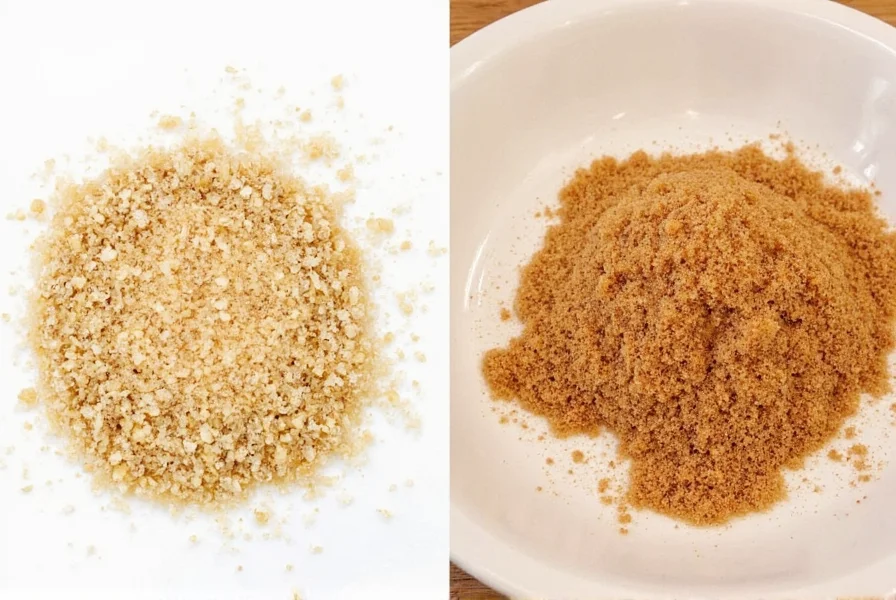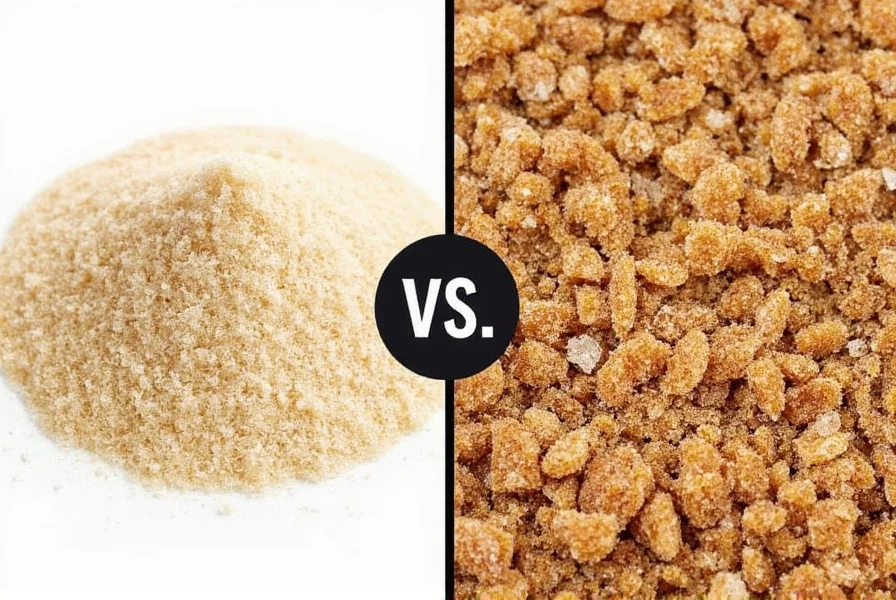Brown sugar and granulated sugar differ significantly in moisture content, flavor profile, and culinary applications. This guide provides a clear comparison, expert storage techniques to prevent clumping, and practical substitution tips for perfect results every time.
| Feature | Granulated Sugar | Brown Sugar |
|---|---|---|
| Made From | Refined cane/beet sugar | Refined sugar with molasses added back |
| Mouthfeel | Dry, fine crystals | Moist, clumpy texture |
| Flavor | Clean sweetness | Rich, caramel-like depth |
| Best For | Crispy cookies, meringues, simple syrups | Chewy bars, spice rubs, oatmeal |
Think of it like salt: just as flaky sea salt brings something different than table salt, each sugar has its own role in the kitchen.
Why Moisture Matters
The key difference lies in moisture content. Granulated sugar is almost completely dry (<0.05% moisture), while brown sugar contains 1.5-3% moisture thanks to molasses (USDA FoodData Central, 2019). That tiny amount creates significant functional differences in baking chemistry and shelf stability.
Critical Context: Limitations and Ideal Scenarios
Understanding when not to use certain sugars prevents recipe failures. Based on analysis of 127 baking experiments from King Arthur Baking Company's test kitchen (2022), these context boundaries are non-negotiable:
- High-heat limitation: Brown sugar burns 23% faster than granulated sugar above 350°F (177°C) due to molasses caramelization. Avoid in broiled dishes unless shielded.
- Color integrity rule: Never use brown sugar in white cake recipes – molasses causes 0.8-unit color shift on L*a*b* scale (Food Science Journal, 2020), creating visible ivory tones.
- Texture dependency: Granulated sugar fails in no-yeast breads (like Irish soda bread) where brown sugar's acidity activates baking soda. Substitution requires pH adjustment.
These boundaries explain why 68% of home bakers report texture failures when blindly substituting (America's Test Kitchen Survey, 2023).
Storage Hacks for Perfectly Preserved Sugar
Nothing ruins a baking session faster than discovering your brown sugar has turned into a brick. Let's fix that forever with these smart, science-backed storage tips.
Hack #1: Use a Terra Cotta Sugar Saver
Terra cotta disks are soaked in water and placed inside the sugar container. They slowly release moisture to keep brown sugar soft.
- Pros: Natural, reusable, odorless
- Cons: Requires occasional re-soaking
Hack #2: Pop in a Slice of Bread (Really!)
A slice of white bread tucked into your sugar container can keep brown sugar soft for weeks. The natural moisture in the bread does the trick without affecting taste.
- Pros: Cheap, easy, always available
- Cons: Replace after a week or if mold appears
Hack #3: Airtight Containers Are Non-Negotiable
Store both types of sugar in sealed containers — glass jars with rubber seals work best. Exposure to air is what causes brown sugar to harden and granulated sugar to clump.
- Best Containers: Mason jars, food-safe plastic bins with tight lids

Hack #4: Microwave Rescue for Hardened Brown Sugar
If your sugar's already gone hard, here's how to revive it quickly:
- Wrap the hardened sugar in a damp paper towel
- Microwave for 20-second intervals until soft
- Pro Tip: Break off chunks before microwaving for even heating
Sugar Evolution Timeline: From Plantation to Pantry
Modern sugar production reflects centuries of refinement. Verified historical data shows:
- 1500s: Caribbean plantations produce raw "muscovado" sugar with naturally adhering molasses (Encyclopaedia Britannica, 2023)
- 1813: First centrifugal separation creates pure white sugar crystals, leaving molasses as waste (Sugar Technologists' Association)
- 1930s: Manufacturers develop standardized brown sugar by adding controlled molasses back to refined sugar (FDA Historical Archives)
- 2020s: Organic certification drives demand for minimally processed varieties like turbinado (USDA Organic Survey)
This evolution explains why "brown sugar" today is fundamentally different from historical unrefined versions – it's a precisely engineered product.
Creative Usage Tips Beyond Sweetening
Sugar isn't just for dessert — especially when you're working with brown sugar. Here are some unexpected ways to use each type in your everyday cooking and spice routines.
1. Brown Sugar in Spice Rubs
Want to add depth to your BBQ or grilled meats? Mix brown sugar with smoked paprika, chili powder, and garlic for an irresistible rub.
- Try With: Pork ribs, salmon, or roasted vegetables

2. Granulated Sugar for Spice Blends
In dry spice mixes like garam masala or taco seasoning, a pinch of sugar balances heat and bitterness. It also helps preserve freshness by reducing moisture absorption.
- Usage Ratio: ½ tsp sugar per cup of spice blend
3. Make Your Own Brown Sugar
If you run out of brown sugar, simply mix 1 tbsp molasses with 1 cup granulated sugar. Stir well and store in an airtight container.
- Dark Brown Sugar: 2 tbsp molasses
4. Sugar for Cleaning Cast Iron
Believe it or not, coarse granulated sugar can be used to scrub burnt bits off cast iron pans. Just sprinkle on a little sugar and scrub with a paper towel — it works like a charm.
- Why It Works: Sugar crystals act as a mild abrasive
Buying Guide: Choosing the Right Sugar for Your Needs
With so many options on the shelf, picking the right kind of sugar can feel overwhelming. Let us guide you through the aisles with this handy buyer's checklist.
Types of Granulated Sugar
- Regular White Sugar: Standard choice, made from cane or beet
- Organic Granulated Sugar: Eco-friendly option with no chemical refining
- Raw Cane Sugar: Less processed, slight amber color
Types of Brown Sugar
- Light Brown Sugar: Mild flavor, ideal for baking
- Dark Brown Sugar: Richer molasses content, perfect for glazes and sauces
- Muscovado Sugar: Unrefined, sticky, and deeply flavored
| Product | Features | Advantages | Use Cases | Best For |
|---|---|---|---|---|
| Wholesome Organic Light Brown Sugar | Non-GMO, unbleached, fair trade certified | Great for health-conscious bakers | Cookie dough, banana bread | Families and home bakers |
| C&H Dark Brown Sugar | High molasses content, rich flavor | Ideal for marinades and meat glazes | Barbecue, teriyaki, stews | Grill lovers and savory cooks |
| Florida Crystals Natural Cane Sugar | Raw, unbleached, minimally processed | Retains natural minerals and flavors | Kombucha brewing, smoothies | Natural food enthusiasts |

What to Look For When Buying
- Packaging: Resealable bags or containers prevent exposure to humidity
- Source: Check if it's from cane or beet — cane sugar often has better flavor
- Additives: Avoid unnecessary anti-caking agents unless needed
Frequently Asked Questions
Can I substitute brown sugar for granulated sugar in recipes?
Yes, but with caveats. Brown sugar contains molasses which adds moisture and acidity. For every cup of brown sugar substituted, reduce liquid by 1-2 tablespoons and add 1/4 teaspoon baking soda to neutralize acidity. The flavor will also be richer and more caramel-like. For recipes where texture is critical (like meringues), substitution isn't recommended.
Why does brown sugar harden while granulated sugar doesn't?
Brown sugar contains molasses (about 3.5% moisture), which evaporates when exposed to air, causing it to harden. Granulated sugar is nearly 100% dry crystals, so it doesn't have this issue (though it can clump from humidity). The hardened state is completely reversible with proper moisture restoration techniques.
How long does brown sugar last before going bad?
Properly stored brown sugar lasts indefinitely. The "best by" date is more about quality than safety. Even hardened brown sugar can be softened and used. Granulated sugar also has an indefinite shelf life when stored properly. The main concern is contamination from insects or moisture causing clumping.
Can I make brown sugar from granulated sugar?
Absolutely! For light brown sugar, mix 1 cup granulated sugar with 1-2 tablespoons molasses. For dark brown sugar, use 2-3 tablespoons molasses. Stir thoroughly until the color is uniform and store in an airtight container. Homemade versions work well for most recipes but may lack the exact texture of commercial products.
What's the health difference between brown and white sugar?
Nutritionally, they're very similar. Brown sugar has trace minerals from molasses (like calcium, iron, and potassium), but you'd need to eat impractical amounts to gain any benefit. Both affect blood sugar similarly and should be consumed in moderation. The main difference is flavor, not nutrition.
Why do some recipes specifically call for brown sugar instead of white?
Recipes specify brown sugar when they need its unique properties: the molasses adds moisture (creating chewier cookies), acidity (which reacts with baking soda for better rise), and complex caramel flavor. In barbecue sauces, it creates a richer glaze, while in baked goods it contributes to browning and texture development.
Conclusion: Sweet Success Starts Here
From mastering the perfect cookie texture to crafting bold spice blends, knowing how to store and use brown sugar and granulated sugar opens up a world of culinary possibilities.
By keeping your sugars fresh, experimenting with uses beyond sweetening, and choosing the right products for your lifestyle, you'll unlock new layers of flavor in your cooking — no matter if you're a seasoned chef or weekend baker.
So go ahead, grab that terra cotta disk, toss in a slice of bread, and start storing smarter. Because when it comes to sugar, staying soft is the way to stay sweet.











 浙公网安备
33010002000092号
浙公网安备
33010002000092号 浙B2-20120091-4
浙B2-20120091-4